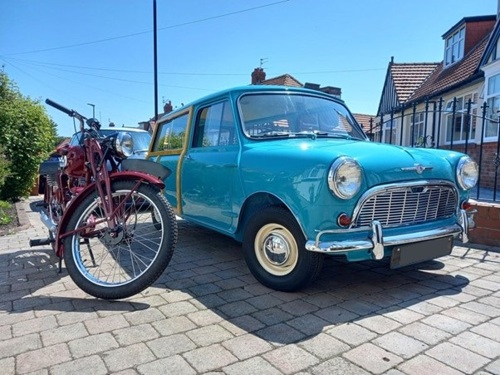Wizardry at Work Again!” - Vic Young’s 1963 Morris Mini Traveller
02 July 2025
Many readers will be instantly familiar with Vic Young’s 1963 Morris Mini Traveller. It has been a star of the Lancaster Insurance Classic Motor Show at the NEC, featured on the cover of Practical Classics, and looks as though it has just left a Morris dealership some 62 years ago.

And the first-generation estates are a key chapter in the Mini’s story. Here are 25
facts about the car that allowed its owner to “Go Modern...Go ‘Mini Travelling’ -
1. BMC launched the Morris Mini Traveller and Austin Seven Countryman on the 16th of September of 1960.
2. According to Jon Pressnell’s fascinating book Mini: The Definitive History: “The design was put together during 1959 in Dick Gallimore’s Longbridge body experimental shop, Doug Adams doing the essential of the work, to the directions of Issigonis, before passing the projects to John Sheppard to be drawn up.”
3. Due to the British Motor Corporation’s rival network of dealerships, they sold the first Mini estate as either an Austin-badged Seven Countryman or a Morris-badged Mini Traveller. Asides from their grilles, the two were identical.
4. The Traveller cost £623 10d – BMC promised “‘Traveller’ motoring at a price you can afford”.
5. BMC made the Countryman and Traveller to ‘De Luxe’ specification with a heater, twin sun visors, and windscreen washers as standard.
6. The Countryman and Traveller also featured wing mirrors, but the interior driving mirror was an optional extra!
7. A Mini Traveller with a two-tone paint finish and whitewall tyres was a star of the Morris stand at the 1960 London Motor Show.
8. With the new Mini Traveller, you too could enjoy “the unique ‘Power Pack’ that combines engine, clutch, gears, and drive axle in one unit”.
9. In 1960, a Mini Traveller had no British direct rival as a front-wheel-drive small estate car.
10. A potential Traveller or Countryman buyer might have considered the Austin A35 Countryman for £623, or the Ford Escort 100E at £616 but their designs dated from the early 1950s.
11. The closest alternative to the Mini Traveller was probably the rear engine Fiat 500 Giardiniera at £585 10s.
12. With the rear seat folded, the Traveller could accommodate 35 ½ cu ft. of luggage.
13. The early sales copy issued strong appeal to a motorist’s inner social climber: “Open those wide rear doors. In go the golf clubs, the week-end cases, and the picnic basket. How about junior's bike? No trouble at all -and by folding the rear seats forward you can have more room still whenever you want it”.
14. The brochure also had some very Enid Blyton-style lines: “Round to the front now - everybody in. Plenty of space for Dad's long legs. Mother's skirt won't get crushed or crumpled in this roomy Traveller. And the children - not to mention the puppy - have got real space to spread themselves!” (With lashings of ginger beer, of course).
15. Not to mention: “The Mini-Traveller will never be short of a job - taking Dad to the station, the kids to school, Mum to the shops, and everybody on wonderful days out and never-to-be-forgotten holidays!”.
16. Somewhat inevitably, ‘Dad’ in the Morris brochure smokes a pipe.
17. Unlike the Morris Minor Traveller, the Mini Traveller’s timber framing was purely decorative. BMC introduced versions sans wood for export in April 1961, but they were not available on the home market until October 1962.
18. When The Motor tested the Austin Seven Countryman, they found it “certainly no less able to engender pride of ownership” than its saloon counterpart.
19. The performance figures recorded by The Motor were a top speed of 67.3 mph with 0-60 in 46.2 seconds.
20. Autocar wrote of the Morris Mini Traveller: “Already holding the reputation of being a great little car, this latest version will certainly enhance this assessment”.
21. John Bolster of Autosport believed “Many families will buy it as a second car, but it will turn out to be the sort of second car that soon takes first place in everybody's affections. At £623 it is more costly than the saloon but represents remarkable value”.
22. Queen magazine thought the Mini estate perfect for fashionable “just marrieds”.
23. Corgi made a splendid die-cast model of the Austin Seven Countryman.
24. Vic’s Traveller is Surf Blue; a colour more popularly associated with the Austin Mini Countryman. Other Morris shades included Fiesta Yellow, Tartan Red, Smoke Grey, Old English White or Almond Green.
25. And to quote the Morris brochure, the Traveller represented “Wizardry at Work Again!”.
With thanks to Vic Young for his time.
With thanks to Vic Young for the permission to use the images in this blog.
